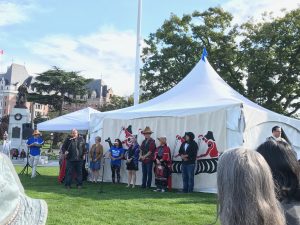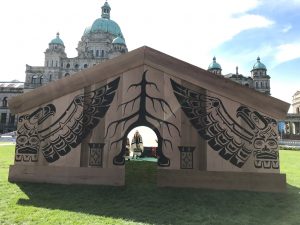From CBC: Sachs Harbour, N.W.T., teen pens song about uncle’s death, garners thousands of views online
This story, published on September 16, 2017, came to my attention from my Facebook feed. Two years ago, a colleague of many years, left Victoria to take a teaching position in Inuvik, Northwest Territories. Jasmine has been Michelle’s student for the last two years. Because the community that Jasmine is from is so remote (Sachs Harbour in Inuvialuit Territory), she stays with a host family in Inuvik while attending high school. At the time of the recording, Jasmine was part of a program that takes part on a ship that sails through the Arctic in the summer, visiting communities and taking part in cultural communities along the way. Apparently, a student from my school, Esquimalt High, recently took part in this program as it is open to any student that applies, who falls within the age restriction. Until the song went “viral”, Michelle did not even know that Jasmine was a singer-songwriter! Another layer to Jasmine’s viral social media experience, is her mother’s story of attending residential school. Sending her daughter away to school, however, was not an option for her.
From CBC: ‘A punch in the gut’: Mother slams B.C. high school exercise connecting Indigenous women to ‘squaw’
This story was published September 18, 2017. A Grade 9 teacher, using the Teacher’s Guide, distributed worksheets to their students that had students associate racist nomenclature with the person of origin. Apparently, the motivation was to teach students what the ubiquitous terminology of the day was, however, as the mother astutely points out, the workbook is void of context, and fails to educate students about relevant information regarding the Indian Act and the reserve system, amongst other knowledge. Turning to Michael’s essay from this week; “ Educators must help students conceptually focus the mirror rather than a magnifying glass at native people.” (p. 499) This workbook perfectly exemplifies the magnifying glass approach. What also should be pointed out, is that the teacher in question, was likely trying to incorporate the new K-9 BC curriculum that has attempted to bring Indigenous knowledge into every course. As a BC teacher, I can say with certainty, that there has not been enough (any?) professional development to facilitate this change so that BCTF members can actually teach Indigenous knowledge with confidence. I am grateful that I am taking ETEC 521 so that I can hopefully avoid making one of my students or their parents feel link I have “punched them in the gut.” Most teachers will not be paying $1600, however, in order to take such meaningful Pro-D. Moreover, I wonder how many teachers will simply side step this portion of the curriculum in fear of making a mistake? <Segway to next article…>
Marker, Michael, “After the Makah Whale Hunt: Indigenous Knowledge and Limits to Multicultural Discourse”, Urban Education, Vol. 41(5), 2006, 482-505.
From CBC: Teachers lack confidence to talk about residential schools, study says
This story was published August 20, 2017. Yes. This is me. Or rather, this was me. I feel fortunate to work at a school that devotes a portion of our Pro-D time, every year, to Indigenous education and the well-being of our Indigenous students. But still, I do not feel like I know enough to say too much in class. With the Truth and Reconciliation Commission being part of mainstream media, combined with some incredibly meaningful Pro-D, I have begun to say more, however. On Orange Shirt Day 2016, I gave my first talk to my homeroom class about the significance of the day— how could I not? I felt like I had finally broken through my self-imposed, block of ice. It is now three weeks into ETEC 521, and I feel more equipped to say what needs to be said, when it needs to be said. I am looking forward to learning more, however, as I know there is much more knowledge to come!
This is Just Us: A Digital Media Documentary
At my high school, we run a course called First Peoples English, in which any student may elect to take this course, in lieu of regular English. Recently, students created the documentary, “This is Just Us.” For whatever reason, I only just learned of this documentary this week (it is amazing what you can find on your school’s website!). It is a bit of a commitment to watch, however, should you have 38 minutes to spare, you will not regret it. In the documentary, Indigenous and non-Indigenous students are interviewed. As well, a local Elder, one of our school’s Aboriginal Educational Assistants and the teacher of the course are all interviewed. Topics that are touched on include: Why Digital Media? What is self-esteem? Who are you thankful for? … and more! I was blown away with the students’ candidness, honesty, bravery and wisdom in their responses. The Elder speaks of running away from his residential school, seeking refuge in Washington. This really drove home the reading of “Borders and the Borderless Coast Salish” from last week. As opposed to the educator who ran into trouble when they attempted to “teach” Indigenous knowledge using an inappropriate “magnifying glass”, Ms. Dunn helped her students “conceptually focus the mirror”, with this project. The project would not have been a success without the partnership with Dano, an actor and director from Tsawout First Nation. Dano came in once a week for a couple of months, and after getting to know the students, he decided that the common thread was how self-esteem affects individuals, families and communities.
Indigenous Leaders on How to Celebrate National Aboriginal Day
This page was published on June 20, 2017, on the University of Toronto’s website. It interviews a variety of Indigenous Leaders (a student, an Elder, and the former National Chief, amongst others), who share how they plan to celebrate June 21 and what any Canadian could also do to recognize this day. I would like to specifically highlight one piece from this page, that addresses the Canada 150 celebrations. This summer, there was a heap of dialogue concerning whether we should be celebrating 150 years of colonialism. Many people I know chose to boycott all July 1 celebrations, and they were not afraid to make it known to all who would listen. Reading this piece, you will find Phil Fontaine’s (albeit brief) take on Canada 150. I don’t think everyone shares his perspective, however, it does exemplify the power of the “positive re-frame”. That is, when a situation is not ideal or seemingly “good”, by changing our perspective a few degrees, we can sometimes see opportunity past the darkness.
Pacific People’s Partnership
PPP is a non-profit organization that promotes sustainability, peace, social justice and community development for Indigenous peoples from the Lekwungen territory in coastal BC and South Pacific Indigenous peoples. I chose this site because I was able to attend a recent event at the BC Legislature on September 16, 2017, The One Wave Gathering. Five local Indigenous youth won a contest that resulted in their work being displayed on the front of four longhouses that were temporarily erected on the Legislature. The fifth artist’s work was made into a dance screen, as the judges were not able to let his work go unnoticed. Both the Songhees and Esquimalt Nation chief’s spoke at the opening ceremony. Chief Andy Thomas described the history of the land that we were meeting on, and how his Great-Great Grandparents were forced to move their village from Victoria’s Inner Harbour to the Esquimalt Harbour. I was particularly moved by the stories of the young artists and I truly felt the sense of proudness that they had of themselves and that their community had for them. That proudness wrapped itself around everyone in attendance. I will put a couple of my pictures on this blog, however, feel free to check out the Instagram hashtag, #onewavegathering to see other pictures and videos.

